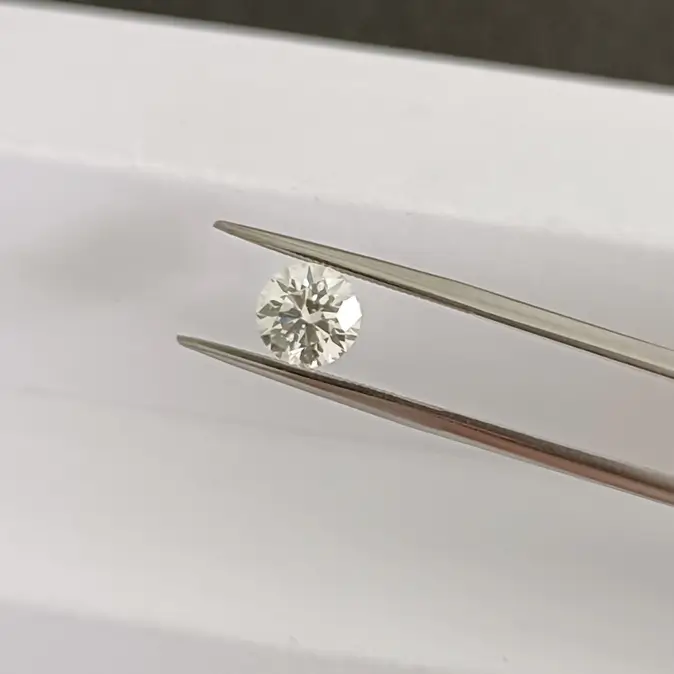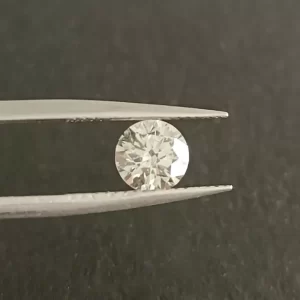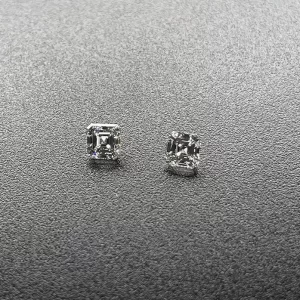Big Size Fancy Cut Lab Grown Diamonds Round Brilliant White Color For Ring HPHT
Big Size Round Brilliant White Color Fancy Cut Lab Diamonds For Ring
Lab Grown Diamonds Description
Laboratory breeding diamond, is a mature production technology is divided into two categories, CVD method and the high temperature and high pressure HPHT method, laboratory breeding diamond, as the name implies, is the simulation of natural diamond growing environment and crystallization properties, under laboratory conditions using seed grows unceasingly, grow up and become, the chemical, physical, atom, The light and all properties are identical to those of natural diamonds.
Characteristics Of Lab Grown Diamonds
Crystal habit:
(1) Lab-grown diamonds are usually cubes, octahedrons and the clustering of the two;
(2) Crystal plane texture: laboratory cultured diamond can show dendritic, sand leakage or intersecting texture, the inoculation surface rough;
(3) Seed crystal: seed crystal and seed crystal phantom zone exist;
(4) laboratory cultivated diamond type: laboratory cultivated diamond is divided into type IIB or TYPE IIA, type IIB after high temperature treatment can become Ib and Ia mixed type;
(5) inclusions: metal inclusions in needle-like, lamellar and needle-point shape. A large number of metal inclusions make synthetic diamond obviously magnetic and even conductive.
Fancy Cut Lab Grown Diamonds – Round Brilliant White Color
A round brilliant diamond is the most popular type of gemstone, but fancy-cut diamonds are available in many other colors, including yellow, orange, pink, and blue. In the case of fancy-cut diamonds, the color is added after the stone is formed, either through irradiation or annealing. In order to create these hues, diamonds undergo a special process known as annealing, which involves the addition of several different types of chemicals.
Colour
There are several factors to consider before purchasing a diamond – most importantly, the colour. Fancy cut lab grown diamonds are almost colourless and ordinary buyers cannot tell the difference. A diamond grade of D is considered colorless, and a diamond grade of F or E is considered a fancy light stone. Lab grown diamonds may show a slight yellowish or bluish tint, but this tint is completely harmless and cannot be seen with the naked eye.
The most common type of pink diamond is D, and it can be pale or a deep shade. Diamonds containing this color are not naturally colorless, and the colour is added to them later through irradiation and annealing. While they may be considered a fancy pink diamond, their actual colour is not a reflection of their origin. Because of this, they are not suitable for engagement rings.
If you prefer a ring with a distinct colour, you can choose from a range of fancy color lab grown diamonds. These diamonds are available in a variety of shades and can be set in traditional solitaire settings. Their colour is often similar to a natural diamond, but they can be cut differently – if they are larger, they can look even brighter. The only difference between natural diamonds and lab-grown diamonds is the origin and the method of production.
Despite their close similarities, lab-grown diamonds may not be colorless and have many flaws. They also differ in the clarity grade. Naturally-occurring diamonds can be colorless or can contain trace amounts of yellow or brown. However, lab-grown diamonds still contain inclusions. If you are looking for a perfect diamond, it is important to understand the color scale of lab-grown diamonds.
Clarity
The clarity and color of fancy cut lab grown diamonds are very similar to those of their natural counterparts. The main difference between these stones is their size. Larger stones can grow up to 15 carats while smaller stones are usually smaller than this. Despite their similar size, lab grown diamonds are not available for sale in the market. These large stones require more time and energy than smaller stones and are usually not sold in the market.
The diamond’s clarity is determined by experts by viewing it under 10X magnification. The experts can examine the diamond under a microscope to detect any surface or internal inclusions. A diamond with VVS clarity grade has no visible inclusions and is therefore valued at a higher price. An inclusion of VS2 or IF1 clarity grade is easy to spot even without magnification. Diamonds with VS2 or I2 clarity grade contain blemishes that are not visible under a 10X magnification.
The size of the inclusion also affects the diamond’s Clarity grade. Smaller inclusions do not affect the diamond’s beauty as much as deep ones do. The more deep the inclusion, the higher the Clarity grade. A diamond with numerous blemishes has a lower Clarity grade. To find the highest quality diamonds, choose a lab that has a good track record of producing flawless diamonds.
Another difference between a lab grown diamond and its natural counterpart is the color. Some lab diamonds contain nitrogen, which gives them undesirable yellow tones. In addition to color, fancy cut diamonds are graded on polish and symmetry. In addition to color, a diamond can have a bluish tint. A diamond with high colorless grade will not have this undesirable tint. However, the clarity of fancy cut lab grown diamonds is usually very high compared to those of the natural counterparts.
Cut
You may be wondering how lab grown diamonds are different from their natural counterparts. The answer is very simple: they are created by undergoing a process known as annealing. During the growing process, diamonds do not receive color. After they have been formed, the color is added to them through irradiation and annealing. This process is completely safe, and a pink diamond cannot be seen with the naked eye.
While both natural and lab grown diamonds are colorless, traditional white diamonds are classified according to their color. They range from D to Z. Usually, a ‘D’ graded diamond has no color at all, and a ‘Z’ graded diamond is clearly a yellow or brownish stone. Because natural diamonds have a colorless grade, lab grown diamonds have the same properties as their counterparts.
There are also special sizes of lab grown diamonds available. Most lab grown diamonds have a clarity grade of VS. They have the same density and weight as natural diamonds. However, this does not mean that the smaller size diamonds are inferior to their full-size counterparts. Moreover, lab grown diamonds are cheaper than natural ones. So, if you’re shopping for a diamond, shop around and compare prices before buying.
There are many advantages of lab grown diamonds over natural diamonds. Although they are often cheaper, they are the same as natural diamonds. They have the same Mohs hardness and crystal structure. That is why they are an excellent alternative to natural diamonds in engagement rings. As long as you know the difference between them, you can make the right decision. Your budget and taste will determine which diamonds you buy.
Carat size
If you are considering purchasing a diamond engagement ring, you may be wondering if you should purchase a natural diamond or a lab grown one. A lab grown diamond is a much better alternative because of its purity. They are made with high pressure/high temperature (HPHT) and chemical vapor deposition (CVD). They grow much faster than natural diamonds and can be purchased for a lower price.
Choosing the carat size of a lab grown diamond is entirely a personal preference. Generally, a difference of 0.5 carats has no effect on the visual size of the diamond, but the price will be much higher. Lab grown diamonds are just as strong and durable as natural diamonds. As a result, many people prefer the bigger size. It can be tempting to buy a diamond with a higher carat size, but do your research!
If you can’t afford a natural diamond, a lab-grown diamond might be the best option for you. These diamonds are formed through a high-temperature carbon growth process. As such, they are complex structures. Because of this, they can be cut into any shape you want. Furthermore, they can be set as a solitaire without other diamonds. If you are unsure of whether a lab-grown diamond is worth the investment, ask a jeweler to show you samples.
While a diamond with a pink tint is not as expensive as a yellow one, it is far more valuable than a similar stone with a yellow or brown tint. Depending on the setting, the color of a diamond may not be as pronounced as a white or pink diamond. However, lab-grown diamonds are often regarded as colorless.
Price
The cost of a fancy cut diamond is directly related to its color, clarity, and carat weight. At a macro level, price is influenced by market demand, production capacity, and other factors. Round F to H colored diamonds are generally less expensive than fancy cut diamonds with deep cuts. Some diamonds undergo post-growth color treatment to increase their value. As a result, the price of these diamonds varies considerably.
The color of a lab-grown diamond can range from icy blue to blush pink. Diamonds graded D and E are colorless, while those with a Z have a noticeable yellow or brown tint. While color grades are based on the 4Cs, a slight difference in appearance isn’t always noticeable. In addition, diamonds in the G-J range are nearly colorless, and as a result, they cost less than diamonds with D, E, or F color.
While the price of a fancy cut lab grown diamond is typically lower than that of a traditional mined diamond, it’s worth noting that diamonds of the same carat weight may not be available at the same price. Because of this, it’s possible to find diamonds of different carat weights, such as one carat, in a variety of shapes. For those who are on a tight budget, lab grown diamonds may be a better option.
A lab grown diamond’s price range depends on the shape, clarity, and color. The most common shapes are round brilliant white, princess, and marquise. While these diamonds may be slightly more expensive than mined diamonds, they are still more affordable than other gemstones. Lab grown diamonds are becoming more popular, and the price of these gemstones has decreased considerably over the last few years.
Big Size Fancy Cut Lab Grown Diamonds Round Brilliant White Color For Ring HPHT


















